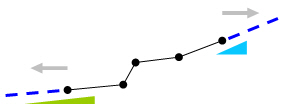Elastic Link
Create or remove elastic links. Two nodes are connected by an elastic link and its stiffness is defined by the user.
From the Main Menu select Model > Boundaries > Elastic Link.
Select Geometry > Boundaries > Elastic Link in the Menu tab of the Tree Menu.
|
Click
|

 2 Nodes
2 Nodes
Enter the node numbers for the 2 nodes to be elastically linked.
 Copy Elastic Link
Copy Elastic Link
Define simultaneously a number of elastic links by copying the conditions assigned to an elastic link.
Node
Inc.
Create a number of elastic link elements using a node increment.
Number of Times: Number of copies
Node Increment: Increment of node numbers
Distance
Create a number of elastic link elements using the distances between
nodes.
Axis: Assign an axis direction for copying the elastic link.
Distances: Enter the number of repetitions and/or distances for copying the elastic link.

